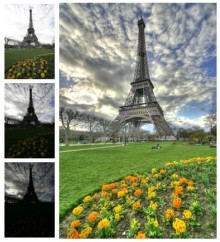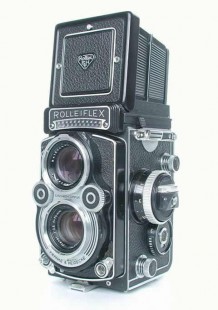In Digital Prints from B&W Negatives, John discusses converting black and white negatives into an HDR image. The image on the right is courtesy of HDR Soft and is the result of their software (albeit on digital images).
As a quick recap, black and white negative film can record a brightness range of about eleven stops (mid grey plus and minus five stops - a range of 1000:1), colour negative film is about seven stops (mid tone plus and minus three/four stops - a range of about 256:1) and colour reversal film is about four stops (plus and minus about two stops - a range of 50:1). Digital sensors can record a similar range of light intensities to colour negative film but are susceptible to burned out highlights, so the exposure needs to be adjusted accordingly i.e. expose for highlights as opposed to exposing for the shadows with negative film. As far as viewing is concerned, a projected transparency can display an illuminance range of about 400:1 whereas the maximum range for a computer screen is about 100:1, a photographic print about 50:1 and a printed magazine page about 10:1) The following Q&A have been selected and precised from the HDR soft website
What is Dynamic Range?
The dynamic range is the ratio between the maximum and minimum values of a physical measurement. Its definition depends on what the dynamic range refers to. The range of luminance human vision can handle is quite large. While the luminance of starlight is around 0.001 cd/m2, that of a sunlit scene is around 100,000 cd/m2, which is a hundred million times higher. The luminance of the sun itself is approximately 1,000,000,000 cd/m2. The human eye can accommodate a dynamic range of approximately 10,000:1 in a single view. To more easily represent such different values, it is common to use a logarithmic scale to plot the luminance. The scanline below represents the log base 10 of the luminance, so going from 0.1 to 1 is the same distance as going from 100 to 1000, for instance. A scene showing the interior of a room with a sunlit view outside the window, for instance, will have a dynamic range of approximately 100,000:
| cd/m | Moonlight | Starlight | Indoor lighting |
Outdoor shade |
Outdoor sunlit |
Sun |
|---|---|---|---|---|---|---|
| Lum | 0.00001 | 0.001 | 1 | 100 | 1000 | 108 |
How do I shoot an HDR image?
Most digital cameras are only able to capture a limited dynamic range (the exposure setting determines which part of the total dynamic range will be captured). This is why HDR images are commonly created from photos of the same scene taken under different exposure levels.
What do you mean by Dynamic Range Increase?
A general problem in photography is the rendering of scenes presenting very bright highlights and deep shadows. The problem already exists with traditional silver halide photography and is more pronounced with slide films. In digital photography, the problem is made even worse as the linear response of the sensors imposes an abrupt limit to the dynamic range captured once the sensor capacity is reached. This is why you can not get what the human eye is seeing when capturing an HDR scene with standard cameras. If you capture details in the shadows thanks to long exposure times, you then get blown-out highlights. Conversely, you can capture details in the highlights with short exposure times, but you then lose contrast in the shadows. There are basically two ways to increase the dynamic range of digital photographs or scanned films
- Exposure blending This process merges differently exposed photographs of the scene into an image with details in both highlights and shadows.
- Tone Mapping This process compresses the tonal range of an HDR image of the scene in order to reveal its details in highlights and shadows.
What is Tone Mapping?
Tone Mapping is the process of converting the tonal values of an image from a high range to a lower one. For instance, an HDR image with a dynamic range of 100,000:1 will be converted into an image with tonal values ranging from just 1 to 255. You may wonder why someone would want to reduce the tonal range when an HDR image provides so many benefits compared to a Low Dynamic Range image. After all, HDR images contain a much higher level of detail and are closer to the range of human vision. The reason is simple: standard display devices can only reproduce a range of about 00: , and paper even less.

